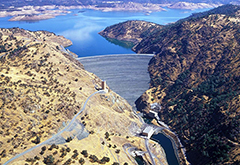1. Oroville Dam:
Oroville Dam is an earthfill embankment dam on the Feather River east of the city of Oroville, California in the United States. At 770 feet (230 m) high, it is the tallest dam in the U.S. and serves mainly for water supply, hydroelectricity generation and flood control. The dam impounds Lake Oroville, the second largest man-made lake in the state of California, capable of storing more than 3.5 million acre-feet (4.4 km3), and is located in the Sierra Nevada foothills east of the Sacramento Valley. More details
2. Hoover Dam:
Hoover Dam, once known as Boulder Dam, is a concrete arch-gravity dam in the Black Canyon of the Colorado River, on the border between the U.S. states of Arizona and Nevada. It was constructed between 1931 and 1936 during the Great Depression and was dedicated on September 30, 1935, by President Franklin D. Roosevelt. Its construction was the result of a massive effort involving thousands of workers, and cost over one hundred lives. The dam was controversially named after President Herbert Hoover. More details
3. Dworshak Dam:
Dworshak Dam is a concrete gravity dam in the western United States, on the North Fork Clearwater River in Clearwater County, Idaho. The dam is located approximately 4 miles (6 km) northeast of Orofino and impounds the Dworshak Reservoir for flood control and hydroelectricity generation. With a height of 717 feet (219 m), Dworshak is the third tallest dam in the United States and the tallest straight-axis concrete dam in the Western Hemisphere. Construction of the dam by the U.S. Army Corps of Engineers (USACE) began in 1966 and was completed in 1973. More details
4. Glen Canyon Dam:
Glen Canyon Dam is a concrete arch dam on the Colorado River in northern Arizona in the United States, near the town of Page. The dam was built to provide hydroelectricity and flow regulation from the upper Colorado River Basin to the lower. Its reservoir is called Lake Powell, and is the second-largest artificial lake in the country, extending upriver well into Utah. The dam is named for Glen Canyon, a colorful series of gorges, most of which now lies under the reservoir. More details
5. New Bullards Bar Dam:
New Bullards Bar Dam is a variable radius concrete arch dam in California on the North Yuba River. Located near the town of Dobbins in Yuba County, the dam forms the New Bullards Bar Reservoir, which can hold about 969,600 acre·ft (1,196,000 dam3) of water. The dam serves for irrigation, drinking water and hydroelectric power generation. More details
6. New Melones Dam:
New Melones Dam is an earth and rock filled embankment dam on the Stanislaus River, about 5 mi (8.0 km) west of Jamestown, California in the United States. The water impounded by the 625-foot (191 m)-tall dam forms New Melones Lake, California's fourth largest reservoir, in the foothills of the Sierra Nevada east of the San Joaquin Valley. The dam serves mainly for irrigation water supply, and also provides hydropower generation, flood control and recreation benefits. More details
7. Mossyrock Dam:
Mossyrock Dam is a concrete arch-gravity dam on the Cowlitz River near Mossyrock in Lewis County, Washington. The reservoir created by the dam is called Riffe Lake and the primary purpose of the dam is hydroelectric production while flood control is secondary. The dam is the tallest in Washington State and its hydroelectric power station supplies 40% of Tacoma Power's electricity. More details
8. Shasta Dam:
Shasta Dam (called Kennett Dam before its construction) is a concrete arch-gravity dam across the Sacramento River in Northern California in the United States. At 602 feet (183 m) high, it is the ninth-tallest dam in the US. Located at the north end of the Sacramento Valley, Shasta Dam creates Shasta Lake – the largest artificial lake in California – for long-term water storage, flood control and hydroelectricity. More details
9. New Don Pedro Dam:
New Don Pedro Dam, often known simply as Don Pedro Dam, is an earthen embankment dam across the Tuolumne River, about 2 miles (3.2 km) northeast of La Grange, California in the United States. The dam serves mainly for irrigation water storage, flood control and hydroelectricity production, and impounds Don Pedro Reservoir in the foothills of the Sierra Nevada. The dam was completed in 1971 after four years of construction. More details
10. Hungry Horse Dam:
Hungry Horse Dam is an arch dam on the South Fork Flathead River in the Rocky Mountains of the U.S. state of Montana. It is located in Flathead National Forest, in Flathead County, about 15 miles (24 km) south of the west entrance to Glacier National Park, 9 miles (14 km) southeast of Columbia Falls, and 20 miles (32 km) northeast of Kalispell. The Hungry Horse project, dam, and powerplant are operated by the United States Bureau of Reclamation. The entrance road leading to the dam is located in Hungry Horse, Montana. More details
11. Grand Coulee Dam:
Grand Coulee Dam is a gravity dam on the Columbia River in the U.S. state of Washington built to produce hydroelectric power and provide irrigation water. It was constructed between 1933 and 1942, originally with two power plants. A third power station was completed in 1974 to increase its energy production. It is the largest electric power-producing facility in the United States. More details










